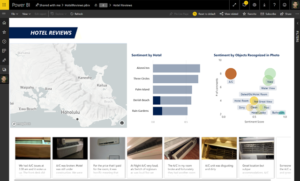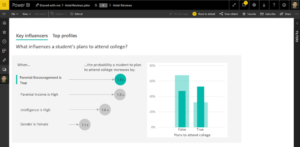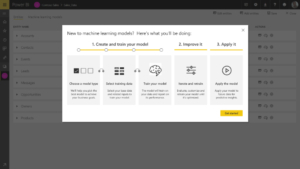Power BI is a great tool that enables every employee to make better decisions based on BI’s reports and dashboards. The downside to this has been the volume of data generated in these reports and dashboards.
This is where Artificial Intelligence can really make a helpful difference. It can automatically filter your data, help with exploration and understanding, find patterns, and predict future outcomes.
So far, the main problem with implementing AI solutions is that it’s very costly for data scientists to do custom solutions for every user. Power BI already makes a lot of these automated tasks easier with its natural language AI capabilities and Quick Insights—and now, Microsoft is adding several new AI features for it.
New AI Features In Power BI
- Image recognition and text analytics
- Better understanding of what influences key business metrics through Key Driver Analysis
- Ability to create machine learning models using automated machine learning
- Seamless integration of Azure Machine Learning
All these new AI capabilities require no code, are easy to use, and let users discover hidden, actionable insights in their data.
Power BI and Azure Cognitive Services
The Azure Cognitive Services are pre-trained machine learning models that can extract insights from data. And now they work in conjunction with Power BI to give you new, powerful ways to extract information from various sources such as documents, social media feeds, and images. The algorithms in Azure Cognitive Services can identify named entities, recognize objects in images, detect language, identify key phrases, and determine if the sentiment regarding an object or entity is positive or negative.
For instance: if you’re a business analyst for a restaurant and want to evaluate guest reviews. With Azure Cognitive Services in Power BI, you can give the algorithms all your online reviews, and it will tell you what your guests liked, and what they didn’t, and pinpoint areas where you can improve.
Microsoft provided an example for hotel management. If you use Power BI in conjunction with Azure Cognitive Services, the insight can surface automatically, and you can see that the hotel has air conditioning issues, which in turn causes customer dissatisfaction, which causes negative reviews.
New Key Driver Analysis feature
Metrics or key performance indicators are important measures for your business success. Still, businesses need to know what impacts those KPIs, know what causes them to go up, down, or stay the same. And, while the obvious business drivers are easy to stop, once they start piling up, things can get very complicated.
This is where key driver analysis helps greatly. This new feature goes over your data, ranks the aspects that matter, and surfaces those key drivers.
For instance, imagine your KPI is going to the gym. Different factors impact whether you can go to the gym on a given day. If you run key driver analysis, it will tell you what matters the most when you’re considering going for a training session.
Microsoft used “going to college” as a KPI below. Note the different factors that impact a child going to college, and how the most powerful influence with significant positive impact is parental encouragement to the future college student’s plans.
Build Your Own Machine Learning Models
With this new feature, business analysts can now build their own machine learning models in Power BI without writing code. This is done through Azure Machine Learning, but rather than target developers and data scientists, it’s been simplified to be accessible for common use cases. So, when an analyst uses power BI to built a machine model, Machine Learning does most of the work by picking the best algorithm and features in a few clicks.
For example, an analyst can use the automated machine learning to easily build a model that predicts how easily a project can be won. This can help prioritize projects to apply for, what to focus on, and the chances of meeting the target.
Integrate Your Azure Machine Learning Models with Power BI
For advanced machine learning, you’ll need specialized data science tools. Data scientists often use Azure Machine Learning to take on those complex models. Now, those models can be shared with your business analysts as well. Power BI will work behind the scenes to discover models a certain user has access to, and automatically creates a point-and-click interface to invoke them, thus greatly improving the collaboration between data scientists and business analysts.
What to get previews of new features before everyone else?
All you have to do is opt-in and you’ll automatically get to try out new features as they’re available!


